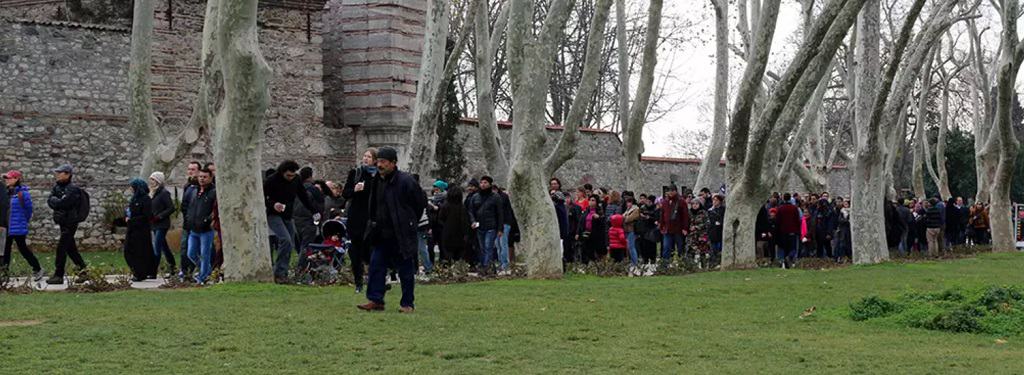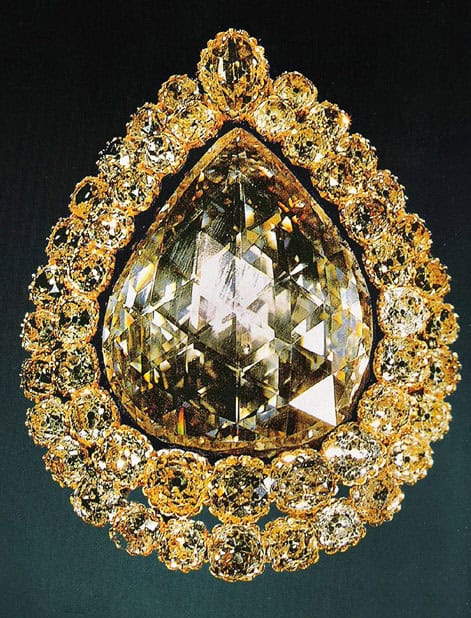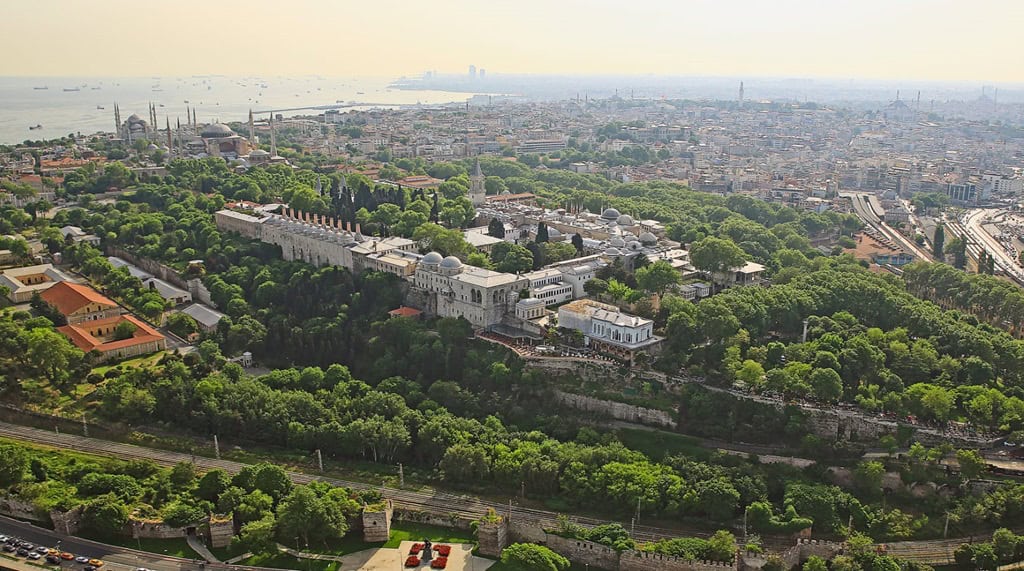کاخ توپکاپی؛ بلیطها، ساعتهای بازدید، هزینه ورود، دیدنیها…
برای جلوگیری از صفهای طولانی در گیشههای بلیط کاخ توپکاپی، میتوانید از اینجا بلیط ورود اولویتدار رزرو کنید یا یک راهنمای رسمی رزرو کنید تا از یک تجربه اختصاصی با ورود سریع بهرهمند شوید. 🌟 میتوانید با خرید بلیط ترکیبی برای ۳ جاذبه پرطرفدار اینجا، از صفها عبور کنید.

کاخ توپکاپی بزرگترین کاخ سلطنتی در امپراتوری عثمانی است که حدود 700,000 کیلومتر مربع وسعت دارد و نزدیک به 400 سال بهعنوان مرکز اداری و فرهنگی امپراتوری خدمت کرده است. این کاخ در سال 1460 به دستور سلطان محمد دوم، پس از فتح کنستانتینوپل ساخته شد و معماری اسلامی را با تأثیراتی از امپراتوری روم شرقی بهشکلی چشمگیر درهم آمیخته است. امروزه این شاهکار تاریخی یک موزه است که هرساله میلیونها گردشگر را با حرمسرا، گنجینههای سلطنتی، آثار مقدس و جاذبههای متعدد دیگر به خود جلب میکند.
این کاخ در سال 1460 به دستور سلطان محمد دوم، پس از فتح کنستانتینوپل ساخته شد و معماری اسلامی را با تأثیراتی از امپراتوری روم شرقی بهشکلی چشمگیر درهم آمیخته است. امروزه این شاهکار تاریخی یک موزه است که هرساله میلیونها گردشگر را با حرمسرا، گنجینههای سلطنتی، آثار مقدس و جاذبههای متعدد دیگر به خود جلب میکند.
فرم تماس برای راهنمای خصوصی ∇
لطفاً نام، شماره موبایل، ایمیل، تاریخها و تعداد افراد را در پیام درج کنید.
قیمت بلیتها / هزینه ورودی
- هزینه ورودی؛ ورود کامل به کاخ اصلی + بخش حرمسرا و کلیسای ایاصوفیه؛ ۱۵۰۰ لیره ترکیه.
- قیمتهای تخفیفدار برای بازدیدکنندگان خارجی؛ ۱۵۰ لیره ترکیه برای دانشجویان خارجی بین ۱۲ تا ۲۵ سال با کارت ISIC.
- ورود رایگان؛ برای تمامی کودکان زیر ۱۲ سال.

⏰ ساعتهای بازدید و روزهای تعطیلی (۲۰۲۵)
روزها و ساعتهای بازدید از کاخ توپکاپی
- روز تعطیل: سهشنبه
- زمان بازشدن گیشه بلیط: 09:00
- زمان بستهشدن گیشه بلیط: 17:00
تعطیلات رسمی و جشنهای مذهبی
- ۲۳ آوریل (روز حاکمیت ملی و روز کودک): باز
- ۱ مه (روز کار و همبستگی): باز
- روز اول عید فطر: تعطیل
- روز دوم عید فطر: باز
- روز سوم عید فطر: باز
- ۱۹ مه (یادبود آتاتورک، روز جوانان و ورزش): باز
- ۱۵ ژوئیه (روز دموکراسی و وحدت ملی): باز
- روز اول عید قربان: تعطیل
- روز دوم عید قربان: باز
- روز سوم عید قربان: باز
- روز چهارم عید قربان: باز
- ۳۰ اوت (روز پیروزی): باز
- ۲۹ اکتبر (روز جمهوری): باز
- روز سال نو میلادی: باز

🚶♂️ بلیطهای Skip-the-Line برای کاخ توپکاپی
در طول فصل شلوغ (از آوریل تا دسامبر)، در روزهای ورود کشتیهای کروز، یکشنبهها و تعطیلات رسمی، ممکن است صفهای کاخ توپکاپی بسیار طولانی باشند. برای جلوگیری از معطلی، میتوانید بلیط را بهصورت آنلاین تهیه کنید که شامل راهنمای صوتی نیز میشود. 🌟 میتوانید با خرید بلیط ترکیبی برای ۳ جاذبه پرطرفدار اینجا، از صفها عبور کنید.

🚋 حملونقل: چگونه به کاخ توپکاپی برویم
کاخ توپکاپی در محله سلطاناحمد استانبول واقع شده و در منطقه تاریخی شهر قدیمی قرار دارد که به شبهجزیره تاریخی نیز شناخته میشود. استانبول شهری است که در دو قاره گسترده شده است و سلطاناحمد در بخش اروپایی این شهر قرار دارد.
برای رسیدن به میدان سلطاناحمد میتوانید از روشهای حملونقل زیر استفاده کنید:
- 🚋 خط تراموای T1: سوار تراموا شوید و در ایستگاه Sultanahmet پیاده شوید. از آنجا حدود ۱۰ دقیقه پیادهروی تا کاخ توپکاپی خواهید داشت.
- 🚇 خط متروی Marmaray: از ایستگاه متروی Sirkeci خروجی شماره ۲ بیرون بیایید و از طریق پارک Gülhane حدود ۱۵ تا ۲۰ دقیقه پیاده بروید که مستقیماً به حیاط اول کاخ میرسید. (توجه داشته باشید که بعضی قسمتهای مسیر سنگفرش شده و دارای سربالایی است.)
- 🚇+🚋 مسیر جایگزین با مترو: از ایستگاه متروی Sirkeci خروجی شماره ۱ خارج شوید، حدود ۲ دقیقه تا خط تراموای T1 پیاده بروید و سوار تراموا شده تا ایستگاه Sultanahmet بروید.
🚍 اطلاعات اتوبوس عمومی: هیچ اتوبوس عمومی که مستقیماً از مقابل کاخ توپکاپی بگذرد وجود ندارد.
🚕 گزینه های تاکسی: اگر ترجیح میدهید با تاکسی بروید، میتوانید از مسیر ساحلی محله جانکورتاران (Cankurtaran) استفاده کنید که در نزدیکی ورودی اصلی کاخ پیاده خواهید شد. بااینحال در ساعات شلوغی (۰۷:۰۰–۰۹:۰۰ و ۱۶:۳۰–۱۹:۰۰) باید منتظر ترافیک سنگین باشید.

🏰 تاریخچه کاخ توپکاپی
کاخ توپکاپی دومین و بزرگترین مجتمع کاخهایی است که توسط عثمانیها در استانبول ساخته شده است. ساخت این کاخ در سال ۱۴۵۳، هفت سال پس از فتح قسطنطنیه توسط محمد فاتح (فاتح سلطان محمد) آغاز شد. اولین کاخ که از چوب در منطقه بیازیت ساخته شده بود، در اثر آتشسوزی تخریب شد و منجر به ساخت کاخ توپکاپی شد. در اصل، این کاخ در دوران عثمانی با نام “کاخ جدید امپراتوری” (سراجدید عماره) شناخته میشد.
زمینهایی که کاخ توپکاپی بر روی آن ساخته شده است، همان منطقهای است که شهر بیزانتیوم برای اولین بار در آن تأسیس شد. دیوارهای بیرونی کاخ توپکاپی بر روی بقایای دیوارهای بیزانتیوم ساخته شدهاند. بنابراین، انتخاب همان زمین که کاخهای بیزانتیوم، روم، امپراتوری شرقی روم و بیزانس در آن قرار داشتند، بسیار نمادین و معنادار است.

این کاخ بر روی مساحتی به وسعت ۷۰۰,۰۰۰ متر مربع ساخته شده و شامل یک باغ وسیع اطراف آن است. کاخ در مجموع دارای ۴۰۰ اتاق است که ۲۰٪ از مساحت کل زمین را ساختمانهای کاخ تشکیل میدهند. امروز، منطقه موزهای ۸۰,۰۰۰ متر مربع را پوشش میدهد (برای مقایسه، کاخ ورسای ۶۷,۰۰۰ متر مربع مساحت دارد و ۲۳۰۰ اتاق دارد). با این حال، از لحاظ معماری، ساختمانهای کاخ به اندازهای که بسیاری از مردم تصور میکنند یا انتظار دارند در مقایسه با کاخهای اروپایی باشکوه نیستند. بزرگی کاخ توپکاپی از کارکرد آن، موزههای آن، تزئینات داخلی و موقعیت آن ناشی میشود.
کاخ توپکاپی به عنوان اولین کاخ امپراتوری تا ساخت کاخ دولماباغچه در سبک باروک استفاده میشد. سلسله عثمانی در سال ۱۸۵۶ به کاخ دولماباغچه نقل مکان کرد و کاخ توپکاپی از سال ۱۹۲۴ به عنوان موزه استفاده میشود.
بخشها
این کاخ از ۳ دروازه اصلی و ۴ حیاط تشکیل شده است. هر حیاط عمومیتر از حیاط بعدی است. بهعنوان نزدیک شدن به کاخ، ابعاد حیاطها کوچکتر و خصوصیتر میشود. همه میتوانستند وارد حیاط اول شوند، در حالی که فقط اعضای سلسله عثمانی میتوانستند وارد حیاط آخر شوند.

دروازه و حیاط اول
اولین دروازه باب همایون (دروازه امپراتوری) و اولین حیاط میدان رژه نامیده میشود. این تنها حیاطی بود که عموم مردم اجازه ورود به آن را داشتند.
دروازه و حیاط دوم
این دروازه مهم بابالسلام (دروازه سلام) و حیاط میدان دیوان (میدان شورا) نامیده میشود. این دروازه که در سبک معماری عثمانی نیست، به سبک مجاری توسط سلطان سلیمان قانونی ساخته شده است. در سمت راست حیاط، آشپزخانههای کاخ و گیشه بلیت و در سمت چپ شورای امپراتوری (دیوان همایون) و اصطبلهای امپراتوری (اصطبل همایون) قرار دارند. علاوه بر این، ورود به حرمسرا، خصوصیترین بخش کاخ، نیز از این حیاط است.
دروازه و حیاط سوم
بابالسعاده (دروازه سعادت) دروازهای است که مراسم در مقابل آن برگزار میشد. این مهمترین دروازه در کاخ است، زیرا سلاطین در طول مراسم در مقابل این دروازه مینشستند. همچنین مکانی است که تمامی مقامات مهم در طول مراسم جشنوارهای صف میکشیدند، دامن سلطان را میبوسیدند و پاداش خود را دریافت میکردند. این میدان اندرون، مدرسه امپراتوری است. حرمسرا نیز بخشی از این سازهها است و میتواند به صورت مستقل مدیریت شود. در این حیاط نیز بخشهای بسیار مهمی از کاخ، مانند اتاق دادخواست (عرز اوضهسی)، خزانه داخلی و اتاق آثار مقدس و همچنین مدرسه امپراتوری (اندرون)، و غیره قرار دارند.
آثار مقدس (کوتسال امانت)
قطعات گرانبهای آثار مقدس کاخ توپکاپی پس از پیروزی سلطان سلیم اول در مصر به استانبول آورده شد. این نمایشگاه در اتاق خصوصی (خاص اوضه) قرار دارد.
- عصای موسی
- شمشیر حضرت داوود (داوود)
- قمیص حضرت یوسف (یوسف)
- آثار حضرت یحیی (یوهنا تعمیددهنده)
- ظرف پختوپز حضرت ابراهیم (ابراهیم)
- عمامه حضرت یوسف (یوسف)
- سجاده نماز حضرت محمد
- پرچم حضرت محمد
- کمان حضرت محمد
- نعلین حضرت محمد، و غیره.
حیاط چهارم
این بخشی است که تنها اعضای سلسله عثمانی، خدمتکاران آنها و مهمانان بسیار خاص میتوانستند وارد آن شوند. در این حیاط چندین عمارت و تراس با چشمانداز دریای مرمره و بسفر وجود دارد. سه عمارت به نامهای بغداد، روان، صوفا و مجیدیه نامیده میشوند. دیگر سازههای این حیاط شامل اتاق ختنه، عمارت افطار و برج پزشک و غیره هستند.


حرمسرا
حرمسرا، مکانی پر از اسرار، در واقع خانه خصوصی سلطان است. خانواده سلطان (والده سلطان، خواهران، شاهزادگان، همسران) به همراه دیگر افراد مانند جواری، معشوقهها، خادمان، نگهبانان، خواجهها و غیره در اینجا زندگی میکردند. حرمسرا در کاخ توپکاپی حدود ۴۰۰ اتاق (کوچک یا بزرگ) دارد. تعداد افرادی که در حرمسرا زندگی میکردند در طول زمان تغییر میکرد. به عنوان مثال، در دوره حکومت سلطان سلیم دوم، جمعیت به ۱۲۰۰ نفر رسید.
حرمسرا بین قرون شانزدهم و نوزدهم استفاده میشد. بخشهای مختلفی که توسط سلاطین مختلف ساخته و تزئین شدهاند، دورههای تغییر در معماری و تزئینات کاخ ترکی را نشان میدهند.
در اینجا سه بخش مهم حرمسرا آورده شده است:
- سالن امپراتوری (حونکار صوفراسی)
- آپارتمان والده سلطان (والده سلطان درهسی)
- اتاق خصوصی سلطان محمد سوم

ایاصوفیه؛ بلیتها، ساعات کاری، تاریخچه
وبسایت رسمی گردشگری استانبول
